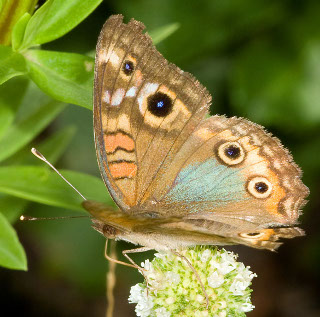Guantanamo's beasts: 51 butterfly species registered at the US naval base
Community and Forum → Blog → Guantanamo's beasts: 51 butterfly species registered at the US naval base
Lev Bely, 11.09.2012 19:41

Researchers from the Florida Museum of Natural History documented 51 butterfly species at the Guantanamo bay US naval base, Cuba. The local wildlife surprisingly turned to be rather rich and abundant with different species.
The naval base, which is spread over about 120 square kilometers in the southeast corner of Cuba, was leased to the US in 1903, and its territory is still not developed much. “Because it is a military base — and this is true for many military bases, which typically have large areas of land — people are not trampling, bulldozing or developing the land,” Roger Portell, the Florida Museum's invertebrate paleontology collections manager, said in a statement. “So there is a large area of land in the southeast corner of the island that has basically been untouched for 100 years.”
During a week expedition in January the researchers gathered 1100 specimens of 192 moth and 41 butterfly species. Among listed there are Fulvous Hairstreak butterfly (Electrostrymon angelia), an invasive swallowtail Common Lime butterfly (Papilio demoleus) that threatens citrus plants, and a subspecies Junonia evarete zonalis of the Nymphalidae family. Along with the butterflies collected in previous years, there are now documented 51 butterfly species in total around Guantanamo.
The authors of this research work, which was published September 5th in The Bulletin of the Allyn Museum (originally published by the Allyn Museum of Entomology in Sarasota, Fla.), said that their study could inform continuing investigations into the biodiversity of the region.
“Biodiversity studies are extremely important, because they give us clues about where things were and how they evolved over time so we can better understand what may happen in the future,” co-author Jacqueline Y. Miller, curator of Lepidoptera at the Florida Museum, said in a statement. “We're also looking at climate change over time, and butterflies are biological indicator species since they are associated with particular plants as caterpillars and often found in particular habitats.”
Butterfly populations are indeed respond immediately to the serious climate changes, as it was when the Rocky Mountains (US) butterflies were to die last spring because of the uncommonly early snowmelts, or ones in the Massachusetts, which some species left and moved north due to the weather got too hot.
LiveScience, http://www.livescience.com
Photo: Junonia evarete zonalis, Stephen Cresswell, http://www.americaninsects.net
All the rest posts on: science, USA, ecology
Comments
New comment
Note: you should have a Insecta.pro account to upload new topics and comments. Please, create an account or log in to add comments.
* Our website is multilingual. Some comments have been translated from other languages.
Random species of the website catalog
News
- 31.12.2024: Если нужно загрузить на сайт много фотографий
- 10.12.2024: Новое поле в «Поиске энтомологов»
- 05.12.2024: Insecta.pro maps: filter by taxon
New photos (28.02.2025)
Fresh from the community
- 20:46, P. Khramov: / Viktor Kolesnikov → Elachista / ...
- 9:16, V. Kolesnikov: Brenthis ino или Brenthis hecate?...
- 8:13, N. Grebennikov: род Elachista (Treitschke, 1833)....
Popular insects
Recommended blog topics
- ICZN Election of Commissioners
- Meanwhile, at the "Reptilium"
- Meantime in Japan
- 1st Butterfly Day to be celebrated in Moscow, Russia, on May 1



























